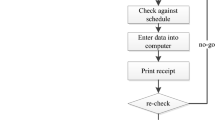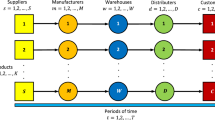Abstract
The current mathematical models for the storage assignment problem are generally established based on the traveling salesman problem(TSP), which has been widely applied in the conventional automated storage and retrieval system(AS/RS). However, the previous mathematical models in conventional AS/RS do not match multi-tier shuttle warehousing systems(MSWS) because the characteristics of parallel retrieval in multiple tiers and progressive vertical movement destroy the foundation of TSP. In this study, a two-stage open queuing network model in which shuttles and a lift are regarded as servers at different stages is proposed to analyze system performance in the terms of shuttle waiting period (SWP) and lift idle period (LIP) during transaction cycle time. A mean arrival time difference matrix for pairwise stock keeping units(SKUs) is presented to determine the mean waiting time and queue length to optimize the storage assignment problem on the basis of SKU correlation. The decomposition method is applied to analyze the interactions among outbound task time, SWP, and LIP. The ant colony clustering algorithm is designed to determine storage partitions using clustering items. In addition, goods are assigned for storage according to the rearranging permutation and the combination of storage partitions in a 2D plane. This combination is derived based on the analysis results of the queuing network model and on three basic principles. The storage assignment method and its entire optimization algorithm method as applied in a MSWS are verified through a practical engineering project conducted in the tobacco industry. The applying results show that the total SWP and LIP can be reduced effectively to improve the utilization rates of all devices and to increase the throughput of the distribution center.
Similar content being viewed by others
References
PAN J C H, SHIH P H, WU M H. Storage assignment problem with travel distance and blocking considerations for a picker-to-part order picking system[J]. Computers & Industrial Engineering, 2012, 62(2), 527–535.
ZHOU Ling, ZHOU Guiliang, XIE Xiaoqian. An optimal storage assignment policy for automated storage and retrieval systems[C]//Education Technology and Computer Science (ETCS), 2010 Second International Workshop on. IEEE, Wuhan, China, 2010, 2: 142–145.
MANTEL R J, SCHUUR P C, HERAGU S S. Order oriented slotting: a new assignment strategy for warehouses[J]. European Journal of Industrial Engineering, 2007, 1(3): 301–316.
ANG M, LIM Y F, SIM M. Robust storage assignment in unit-load warehouses[J]. Management Science, 2012, 58(11): 2114–2130.
MENEGHETTI A, MONTI L. Sustainable storage assignment and dwell-point policies for automated storage and retrieval systems[J]. Production Planning & Control, 2013, 24(6): 511–520.
CHEN Lu, LANGEVIN A, RIOPEL D. The storage location assignment and interleaving problem in an automated storage/retrieval system with shared storage[J]. International Journal of Production Research, 2010, 48(4): 991–1011.
GUO Shin-Ming, LIU Tsai-Pei. An evaluation of storage assignment policies for twin shuttle AS/RS[C]//Management of Innovation and Technology (ICMIT), 2010 IEEE International Conference on. IEEE, Singapore, 2010: 197–202.
ADIL G K. A branch and bound algorithm for class based storage location assignment[J]. European Journal of Operational Research, 2008, 189(2): 492–507.
ADIL G K, MUPPANI V R, BANDYOPADHYAY A. A review of methodologies for class-based storage location assignment in a warehouse[J]. International Journal of Advanced Operations Management, 2010, 2(3): 274–291.
ADIL G K. Efficient formation of storage classes for warehouse storage location assignment: a simulated annealing approach[J]. Omega, 2008, 36(4): 609–618.
ROODBERGEN K J, VIS I F A. A survey of literature on automated storage and retrieval systems[J]. European Journal of Operational Research, 2009, 194(2): 343–362.
GU J, GOETSCHALCKX M, MCGINNIS L F. Research on warehouse design and performance evaluation: A comprehensive review[J]. European Journal of Operational Research, 2010, 203(3): 539–549.
DE KOSTER R, LE-DUC T, ROODBERGEN K J. Design and control of warehouse order picking: A literature review[J]. European Journal of Operational Research, 2007, 182(2): 481–501.
CHUANG Yi-Fei, LEE Hsu-Tung, LAI Yi-Chuan. Item-associated cluster assignment model on storage allocation problems[J]. Computers & Industrial Engineering, 2012, 63(4): 1171–1177.
XIAO Jian, ZHENG Li. Correlated storage assignment to minimize zone visits for BOM picking[J]. The International Journal of Advanced Manufacturing Technology, 2012, 61(5–8): 797–807.
CHIANG David Ming-Huang, LIN Chia-Ping, CHEN Mu-Chen. The adaptive approach for storage assignment by mining data of warehouse management system for distribution centers[J]. Enterprise Information Systems, 2011, 5(2): 219–234.
MARCHET G, MELACINI M, PEROTTI S, ET AL. Analytical model to estimate performances of autonomous vehicle storage and retrieval systems for product totes[J]. International Journal of Production Research, 2012, 50(24): 7134–7148.
MARCHET G, MELACINI M, PEROTTI S, et al. Development of a framework for the design of autonomous vehicle storage and retrieval systems[J]. International Journal of Production Research, 2013, 51(14): 4365–4387.
BASKETT F, CHANDY K M, MUNTZ R R, et al. Open, closed, and mixed networks of queues with different classes of customers[J]. Journal of the ACM (JACM), 1975, 22(2): 248–260.
BOLCH G, GREINER S, DE MEER H, et al. Queuing networks and Markov chains: modeling and performance evaluation with computer science applications[M]. John Wiley & Sons, 2006.
PUJOLLE G, WU A. A solution for multi-server and multiclass open queuing-networks[J]. INFOR, 1986, 24(3): 221–230.
WHITT W. The queuing network analyzer[J]. Bell System Technical Journal, 1983, 62(9): 2779–2815.
WANG Yanyan, WU Yaohua, WU Yingying, et al. Restocking buffer optimization of automated picking system[J]. Chinese Journal of Mechanical Engineering, 2012, 48(24): 174–180. (in Chinese)
DORIGO M, BIRATTARI M. Ant colony optimization[M]// Encyclopedia of Machine Learning. Springer US, 2010: 36–39.
JAFAR O A M, SIVAKUMAR R. Ant-based clustering algorithms: A brief survey[J]. International Journal of Computer Theory and Engineering, 2010, 2(5): 1793–8201.
Author information
Authors and Affiliations
Corresponding author
Additional information
Supported by National Natural Science Foundation of China (Grant No. 61403234), and Shandong Provincial Science and Technology Development Plan of China (Grant No. 2014GGX106009)
Biographical notes
WANG Yanyan, born in 1978, is currently a post-doctoral research fellow at Shandong University, China. She received her PhD degree from Shandong University, China in 2012. Her research interests include the optimization of automated order picking and storage systems in logistics distribution.
MOU Shandong, born in 1989, is currently a postgraduate student at Modern Logistics Research Center, Shandong University, China. His main research interests consist of the optimization of automated order picking systems in logistics distribution.
WU Yaohua, born in 1963, is currently a professor at Shandong University, China. He received his PhD degree from Tsinghua University, China, in 1996. His main research interests are in the field of facility planning.
Rights and permissions
About this article
Cite this article
Wang, Y., Mou, S. & Wu, Y. Storage assignment optimization in a multi-tier shuttle warehousing system. Chin. J. Mech. Eng. 29, 421–429 (2016). https://doi.org/10.3901/CJME.2015.1221.152
Received:
Revised:
Accepted:
Published:
Issue Date:
DOI: https://doi.org/10.3901/CJME.2015.1221.152




